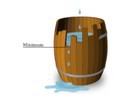Guest blogger Ed Hardy recently wrote the following for AHDB GrowSave and it was an interesting thought worth sharing.
I was recently reminded of Liebig’s Barrel, which depicts a wooden barrel with staves (the wooden planks) of differing lengths. The concept applies to plant growth, with each stave representing a different input necessary for effective crop production. Growers are probably familiar with the main idea of the analogy: in the same way that the barrel can only be filled as high as its shortest stave, so too will plant growth be limited by the nutrient or input in shortest supply.
Liebig’s Barrel, which depicts a wooden barrel with staves (the wooden planks) of differing lengths. The concept applies to plant growth, with each stave representing a different input necessary for effective crop production. Growers are probably familiar with the main idea of the analogy: in the same way that the barrel can only be filled as high as its shortest stave, so too will plant growth be limited by the nutrient or input in shortest supply.
With carbon-foot printing, energy efficiency and a general desire to optimise profitability all playing a part in operating a successful and sustainable business, how can Liebig’s Barrel help? In my experience, many growers still take a somewhat inefficient approach by supplying more of their valuable resources to the crop than is necessary. For example, some insist on maintaining minimum pipe temperatures, leaving supplementary lighting on for a set number of hours, or achieving minimum CO2 levels. This is fine if you know it’s the limiting factor affecting plant development, but you are probably wasting money if it isn’t.
So, what can you do about it? Identifying which element of plant development is the limiting factor at any given moment can be challenging, although with the plethora of sensors and tools available for data collection and analysis these days, it’s not impossible. Modern greenhouses can be high-tech environments requiring significant investment. However, if it means reduced operating costs and improvements in crop health and productivity, it can be money well spent.

 NFU Energy
NFU Energy